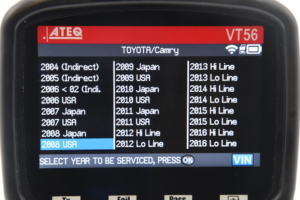Back to the news page
12.23.2018
TPMS diagnostic information on the top-selling vehicles of 2008 – Toyota Corolla

If performing TPMS services, such as replacing one or more TPMS sensor ID’s or rotating tires, a TPMS relearn procedure must be performed using a basic TPMS activation tool or an advanced TPMS scan tool, depending on the vehicle’s TPMS system. A TPMS relearn, often called TPMS reset, will write the new TPMS sensor ID locations to the vehicle’s ECU, which will cure the TPMS MIL.
According to U.S. News and World Report, the top three selling vehicles in 2008 were:
Each week, we will explore the diagnostics of the TPMS system of each vehicle, and teach you how to properly reset the system. This week, we will be going over the 2008 Toyota Corolla.
Before performing a relearn procedure, it is important to make sure the TPMS sensors are installed properly, and tires are inflated to placard pressure.

All service kits and OE-type (one-to-one) TPMS sensor options for the Toyota Corolla 2008 can be found in your VT56, VT55, and VT36 TPMS Tools in “Service TPMS”.

Some Toyota models have a “SET” or “TPMS RESET” button, which is located below the steering wheel or under the glovebox. When the button is pressed, the system tries to locate the sensor ID’s that are already stored. The “SET button” can be used when performing a tire rotation that has different tire pressures in the front and rear, changing or adjusting the tire pressure, or changing tire size, or when tires are replaced.
If the “SET” button is pushed after new sensor IDs are introduced and before a relearn is performed, the ECU must be unlocked in order for the relearn procedure to work correctly. Some advanced TPMS scan tools have the capability to unlock the ECU. If your TPMS scan tool has the “UNLOCK ECU” option, the relearn procedure can be properly performed.

When selecting the Make, Model and Year of your vehicle, you will notice there are two options for the Year from 2006 to 2011: USA or Japan. It is very important to select the correct selection of “2008 USA” or “2008 JAPAN” with the VT56, Quickset, or your diagnostic scan tool since there is a slight difference in the way the TPMS information is transferred to the vehicle’s ECU.
To find out whether the Toyota Corolla you are working with was manufactured in Japan or USA, take a look at the vehicle’s VIN barcode, particularly the first character of the VIN.

Some Toyota Corolla years since 2006 have the option to purchase the vehicle with a spare tire, which has a TPMS sensor. During the relearn procedure, you must also activate the spare tire TPMS sensor to reset the system properly and write all the TPMS ID’s to the vehicle’s ECU. If the spare tire is not activated, the TPMS light will still indicate a TPMS MIL. When selecting the Make Model and Year, you will be prompted to select 4 or 5 tires. To find out whether your Toyota Corolla came manufactured with a spare tire, check for the following indications:
The order is as follows: Left front, Right Front, Right Rear, Left Rear, Spare Tire
| C2111/11 | (transmitter ID1 operation stop) |
| C2112/12 | (transmitter ID2 operation stop) |
| C2113/13 | (transmitter ID3 operation stop) |
| C2114/14 | (transmitter ID4 operation stop) |
| C2115/15 | (transmitter ID5 operation stop) |
| C2121/21 | (no signal from transmitter ID1 in Main mode) |
| C2122/22 | (no signal from transmitter ID2 in Main mode) |
| C2123/23 | (no signal from transmitter ID3 in Main mode) |
| C2124/24 | (no signal from transmitter ID4 in Main mode) |
| C2125/25 | (no signal from transmitter ID5 in Main mode) |
| C2126/26 | Transmitter ID Not Received In Main Mode |
| C2127/27 | Transmitter ID Not Received In 2nd Mode |
| C2131/31 | (no signal from transmitter ID1 in 2nd mode) |
| C2132/32 | (no signal from transmitter ID2 in 2nd mode) |
| C2133/33 | (no signal from transmitter ID3 in 2nd mode) |
| C2134/34 | (no signal from transmitter ID4 in 2nd mode) |
| C2135/35 | (no signal from transmitter ID5 in 2nd mode) |
| C2141/41 | Transmitter ID1 Error |
| C2142/42 | Transmitter ID2 Error |
| C2143/43 | Transmitter ID3 Error |
| C2144/44 | Transmitter ID4 Error |
| C2145/45 | Transmitter ID5 Error |
| C2165/65 | Abnormal Temperature inside ID1 Tire |
| C2166/66 | Abnormal Temperature inside ID2 Tire |
| C2167/67 | Abnormal Temperature inside ID3 Tire |
| C2168/68 | Abnormal Temperature inside ID4 Tire |
| C2169/69 | Abnormal Temperature inside ID5 Tire |
| C2171/71 | Transmitter ID Not Registered In Main Mode |
| C2172/72 | Transmitter ID Not Registered In 2nd Mode |
| C2173/73 | VSS (Vehicle Speed Sensor) Or ESS (Engine Speed Sensor) Signal Malfunction |
| C2174/74 | Vehicle Speed Signal Malfunction |
| C2176/76 | Receiver Error |
| C2177/77 | Initialization Not Complete |
| C2178/78 | Battery Voltage Malfunction |
| C2179/79 | Tire Pressure Monitor ECU Communication Stop |
| C2181/81 | Transmitter ID1 Not Received (Test Mode) |
| C2182/82 | Transmitter ID2 Not Received (Test Mode DTC) |
| C2183/83 | Transmitter ID3 Not Received (Test Mode DTC) |
| C2184/84 | Transmitter ID4 Not Received (Test Mode DTC) |
| C2185/85 | Transmitter ID5 Not Received (Test Mode DTC) |
| C2191/91 | Vehicle Speed Signal Error (Test Mode DTC) |
| C2192/92 | Select Switch Error (Test Mode DTC) |
| C2194/94 | Engine Speed Signal Circuit Malfunction (Test Mode DTC) |
| C2195/95 | Multi-receiver Antenna Circuit (Test Mode DTC) |
The aftermarket provides technicians with many optio...
TPMS relearn procedure and other TPMS diagnostic sys...
Technological factors behind the TPMS tool you are u...